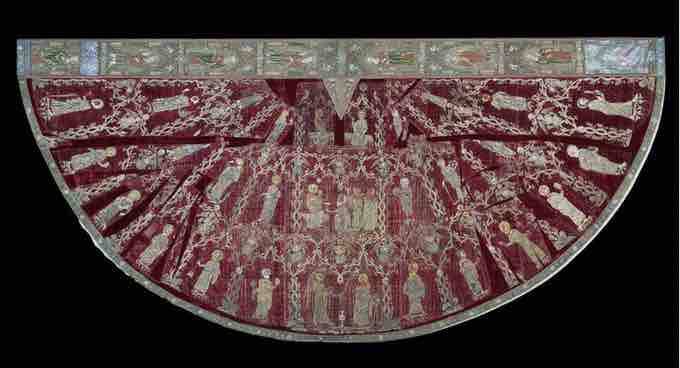Overview: The Opus Anglicanum
Opus Anglicanum, Latin for "the English work," refers to the elaborate needlework produced in England during the the middle ages. Embroidered pieces were used in religious and secular settings on vestments, clothing for the wealthy, and heraldic tapestries. England gained a reputation for needlework as early as the Anglo-Saxon period prior to the Norman conquest; however, it was the in the 13th and 14th centuries that the Opus Anglicanum really flourished.
Style
The stye of the work of this era involved combining silk and gold or silver-gilt threads worked on linen, and later velvet. The motifs used in needlework followed the trends in other forms of art at the time, such as illuminated manuscripts and architecture; some motifs including the use of scrolls, spirals, and foliage. Embroidered pieces also depicted figures of kings and saints, as well as the Gothic arches popular in architecture in Europe during this period.
Craftsmen
London was the primary center of production for Opus Anglicanum. While it is often associated with certain convents, a professional group of male craftsmen produced a great deal of the work. The Worshipful Company of Broderers was the craft guild that was incorporated in 1561 to represent these workers. There is some evidence that the group had first incorporated as early as 1515, but those records were lost.
Use
Opus Anglicanum consisted primarily of popular luxury items that spread across Europe. Pope Martin IV, for example, ordered pieces made for him after admiring the vestments of English Priests. As the 14th century progressed, however, demand for luxury goods decreased as funds were re-directed toward military expenditures. As a result, the style of the work was scaled back, and much of the richness and storytelling involved in these pieces was lost. The work instead often became small applique pieces that could be added to clothing or tapestries.
Few pieces have survived due to the delicate nature of the work. Some were re-purposed as they aged, and other pieces were even buried with their owners. Some of the surviving pieces include a cope, or a type of vestment, owned by the Butler-Bowdon family. Thought to have been made in 1330-1350, the Butler-Bowdon Cope is an example of a piece that was cut up for re-use, as it was reconstructed in the 19th century.

Butler-Bowden Cope
This picture is one of the few examples of Opus Anglicanum that has survived. It was reconstructed in the 19th century.